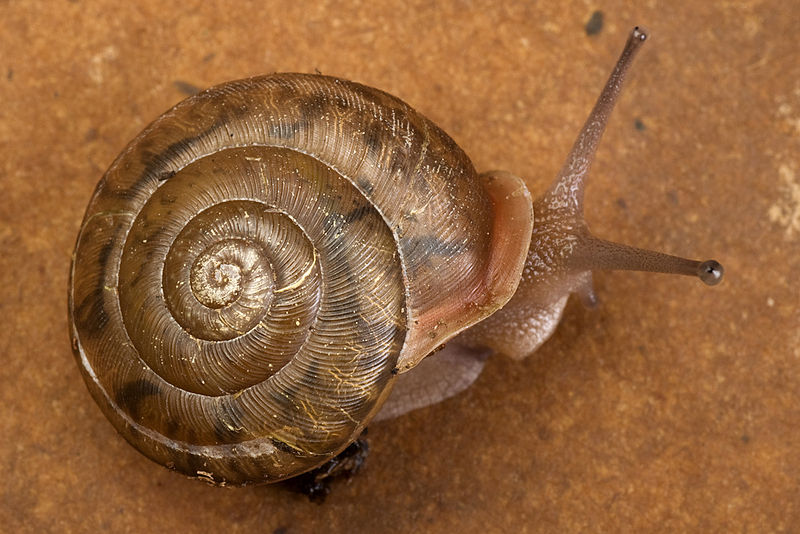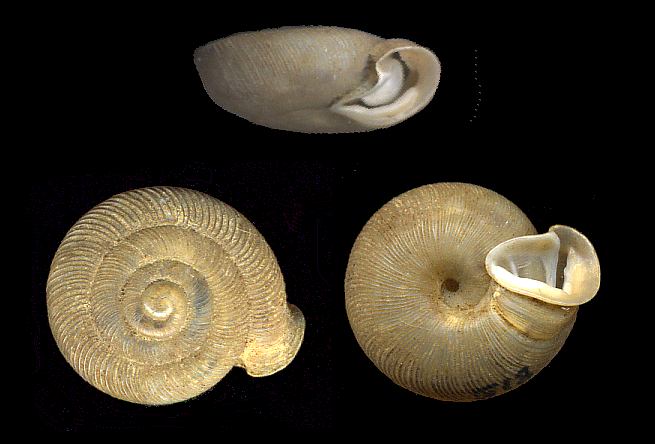
Adaptation

Gastropods are extremely versatile creatures that adapted many different ways of living. Proof of this is evident in the immense diversity seen in 70,000 Gastropods in existence today (Hickman et al 2012). The Pulmonates are an excellent example of adaptation occurring within the Phylum Gastropoda. On this page two general adaptations are discussed that applies to Millerelix lithica and other land snails.
ADJUSTING TO LIFE ON LAND
As I'm sure everyone is aware, terrestrial life is drastically different than life in water. One major obstacle land snail had to overcome is respiration of atmospheric oxygen. This dilemma was solved when gills meant for underwater respiration were substituted by a lung. The lung of Pulmonates is situated in the mantle cavity inside the shell
(Boer et al 1975). A picture of the placement of the lung can be viewed on the Reproduction page. Snail are unlike people in how air enters the lungs. Instead of inhaling through the mouth or nose, a Pulmonate has an opening called the pneumostome that allows air to enter the mantle cavity (Boer et al 1975). Once air enters, the base of the mantle cavity circulates the air by muscular contractions (Boer et al 1975). Lastly, the lungs function by replenishing the oxygen in the blood to be dispersed for the rest of the body to use and removing other waste such as carbon dioxide.Another issue Pulmonates faced was threat of drying up due to excess water loss. This was not a problem for their aquatic relatives, because they are completely surrounded by water at all times. Land on the other hand, differs in the amount of moisture depending on the location. Even though Pulmonates have made the transition to land, they still face challenges in staying hydrated.
The primary reason for water loss is that the snails have permeable skin where water can easily enter or leave which makes evaporation a big threat
(Denton et al 1964). This is also a positive quality for the snail, because during wet conditions the snail is able to absorb needed water throughout the skin. Another supplementary cause of dehydration is the loss of water by using mucus for movement (Denton et al 1964). For these reasons land snails tend to adventure about when it is raining or at night so they aren't fried by the sun. When conditions aren't so wet, the snail has several methods to prevent unwanted water evaporation. For instance, most of the forest dwelling Pulmonates occupy places that are moist and humid to prevent unwanted water loss(Pilsbry 1940). All in all the snail must be continually conscious about its hydration.
DEFENSE
Probably the most notable adaptation of the snail is the presences of its hard calcium carbonate shell
(Dourson 2010). The presence of the shell or valve is main reason for the success of the members of the phylum Mollusca. The most obvious function of a Gastropods shell is to provide protection against predators. Most of the snails vital organs are permanently enclosed in its shell making it very difficult for a predator to breach. Not only are the visceral organs safe, even the exposed soft head and foot of the snail can be retracted inside the shell during times of danger (Denton et al 1964).
 In Pulmonates the shell provides an additional function along
side of protection from predators. The shell of a Pulmonate also
provides a safe haven when conditions are bad. For instance
retreating into the shell during dry conditions can be an effective
method for retaining water (Denton
et al 1964). Also, the shell is a
great insulator which allows the snail to regulate its temperature
(Denton
et al 1964). This insulating
property is a great advantage for the snail to withstand drastic
temperature changes that occurs on land which is the reason land
snails can make it through the winter. Like other animals who aren't
afforded the luxury of heating, snail undergo hibernation within
their shell which is known as estivation (Denton
et al 1964). The aperture is mostly
sealed from the outside world by teeth that are present in genus
Millerelix (Pratt
1981, Pilsbry 1940).
In Pulmonates the shell provides an additional function along
side of protection from predators. The shell of a Pulmonate also
provides a safe haven when conditions are bad. For instance
retreating into the shell during dry conditions can be an effective
method for retaining water (Denton
et al 1964). Also, the shell is a
great insulator which allows the snail to regulate its temperature
(Denton
et al 1964). This insulating
property is a great advantage for the snail to withstand drastic
temperature changes that occurs on land which is the reason land
snails can make it through the winter. Like other animals who aren't
afforded the luxury of heating, snail undergo hibernation within
their shell which is known as estivation (Denton
et al 1964). The aperture is mostly
sealed from the outside world by teeth that are present in genus
Millerelix (Pratt
1981, Pilsbry 1940).
Click here to learn about the nutrition of M. lithica
home
|
classification |
controversy
| habitat
| adaptation
| nutrition
| reproduction
| references
|
contact
last updated November 29, 2012